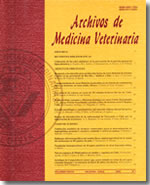Plasma and faecal disposition kinetic of moxidectin after oral admnistration in horses
Main Article Content
Abstract
A study was undertaken with the aim to study the plasma disposition kinetic and the faecal excretion profile of moxidectin after oral administration in horses. Five mixedbred saddle horses of 416.8 ± 49.5 kg body weight and positives to the nematodes' faecal eggs count were treated with an oral gel formulation of moxidectin (Equest" ) at doses of 0.4 mg/kg. Blood and faecal samples were collected before and at different times after treatment for a period of 75 days. After solid phase extraction and derivatization samples were analysed by high performance liquid chromatography (HPLC). Data were analysed by a computerised kinetic analysis.
The limit of quantification of the method was 0.5 ng/mL and the drug was detected in the plasma between 30 min (33.9 ± 17.8 ng/mL ) to 75 days post administration ( 0.3 ± 0.2 ng/mL ). The analysis of pharmacokinetic parameters showed a short half life of absorption ( t _ ab 0. 84± 0.5 h) and values of maximum concentration (Cmax ) of 68.7 ± 24.1 ng/mL obtained at 0.117 ± 0.07 d (Tmax). The terminal half life of elimination (t _b) was 18.3 ± 3.2 d, which produces a delayed mean residence time (MRT of 19.6 ± 4.6 d). The area under the concentration time curve was 172.3 ± 51.2 ng· d / mL. The mean concentration of moxidectin in faeces ranged between 423.5 ± 570.7 ng/g at 24 h and 0.8 ± 0.8 ng/g 75 d after treatment. The mean maximum faecal concentration (Cmax) 5204.5± 916.5 ng/g was observed at 2.5 d post-treatment. It is concluded that moxidectin has a delayed period of permanency in the organism when it is administered by oral route in horses.

